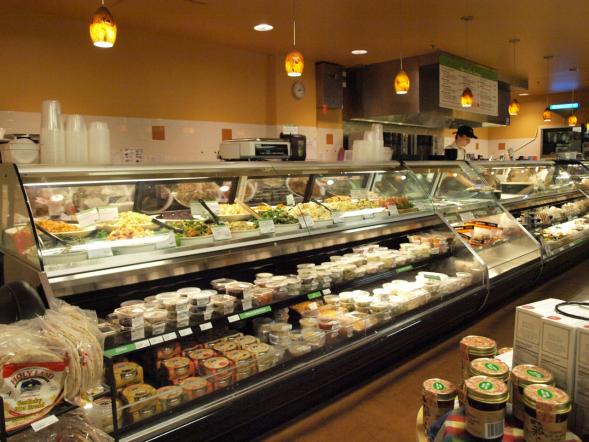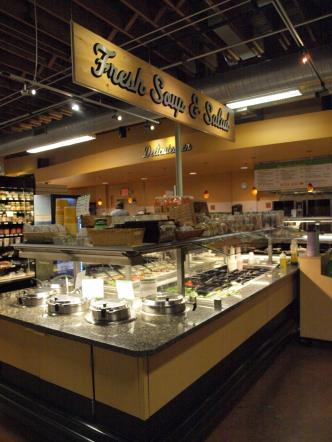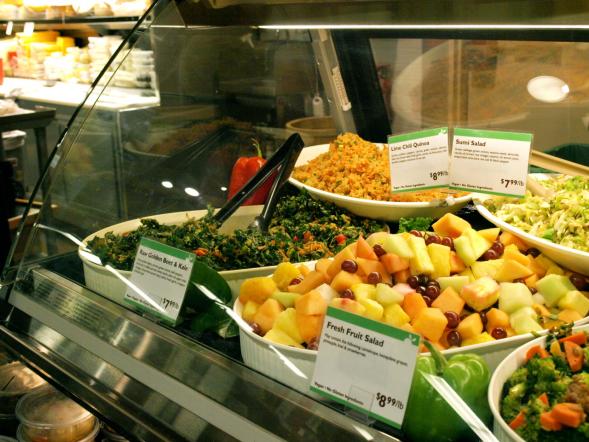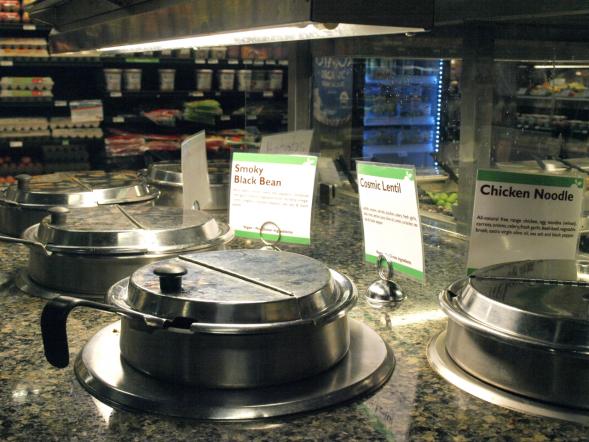This is the seventh post in our Co-op on a Budget series, which explores the different ways that we can shop co-op effectively and affordably. Also check out posts on shopping bulk, the Wedge Co-op vs. Cub Foods, Eastside Food Co-op vs. Rainbow, a class on eating economically, and DIY Supplies.
One of the things I like the most — and the least — about my full-time job as a behavior therapist for children with autism is eating on the road. Although I like the flexibility of my schedule, it’s challenging to balance seeing clients and still fitting in time for a healthy meal. Now add in my commitment to a locavore diet and cautious spending, and lunchtime gets a lot more complicated.
During the middle of my work day, one of two things usually happens: I’m rushing from one city to another, holding the steering wheel with one hand and scarfing down my brown bag lunch with the other, or I have a few hours open between appointments but am too far out to head back home. I’ve found the best way to spend these longer breaks is grabbing lunch and a chat session with a girlfriend or eating a sandwich with my laptop, crossing things off my to-do list.
It only took a few months of eating 2-3 lunches out every week to see the damage to both my bank account and my dress size. I’d swipe $10-20 on my credit card, find myself in front of greasy fast food or an overpriced restaurant plate, and then have to head back to work for the afternoon. I never knew which was worse, adding up the bill or adding up the calories.
 The deli at the Linden Hills Co-op
The deli at the Linden Hills Co-op
A few years ago, a friend asked me to grab lunch somewhere near the University of Minnesota campus. He only had a bike and I only had an hour. He’s a vegetarian and I’m a locavore. We both were on fresh-out-of-college budgets. And so, our lunch hour at the Seward Co-op was born.
I couldn’t have been more hesitant about eating lunch at a grocery store that day. Visions of slimy deli meat and fluorescent yellow potato salad were running through my head all morning. In the end I had the same reaction that most of my friends now have the first time I take them to the co-op for lunch: pleasantly surprised. My salad was fresh and full of local veggies. My bill was under $10. And I didn’t have to spend the lunch hour anxiously checking between the clock and the waiter wondering if the food will be ready so I can make it back to work in time.
Now almost all of my friends expect an invitation to a co-op when I say ‘Let’s do lunch.’ Eating out will always be more expensive than packing a brown bag lunch. But if I want to spend my dollars and my time wisely, I’ve found there’s no better place than the neighborhood co-op. Here’s why you can’t go wrong:
Co-ops are everywhere
 The salad bar at the Linden Hills Co-opThe Twin Cities is lucky to
be dotted with co-ops all around the metro. Whether I’m seeing a client in
Burnsville or South Minneapolis, I’m never very far from a co-op. All of the
metro co-ops offer grab-and-go lunch items and most have a full-service deli
counter with a comfortable place to sit.
The salad bar at the Linden Hills Co-opThe Twin Cities is lucky to
be dotted with co-ops all around the metro. Whether I’m seeing a client in
Burnsville or South Minneapolis, I’m never very far from a co-op. All of the
metro co-ops offer grab-and-go lunch items and most have a full-service deli
counter with a comfortable place to sit.
If you have special food needs, the co-op has options
As I mentioned above, it can be hard to find lunch-hour options for anyone with special food needs. I have friends who choose vegan, vegetarian, gluten-free, or kosher diets. For me, finding a lunch of mostly local ingredients is a top priority. But I also have friends who eat more traditional diets and get queasy at the thought of ‘health food’. Finding a lunch spot where the club sandwich and potato chips is just as good as the vegan tofu wrap is tough. I’ve yet to take someone out to lunch at the co-op who didn’t find something they enjoyed.
Did I mention the co-op has options?
Hitting up the co-op for lunch means that I rarely have the same meal twice. One day I can make a salad at the salad bar, the next day I can have a bowl of hot soup and a sandwich. Co-ops like Linden Hills, Mississippi Market, and the Wedge are well-known for their specialty deli dishes like gourmet salads, homemade sausages, and some stellar hot sandwiches. I often catch myself saying ‘oooh…that looks so good,’ with my face pressed up on the deli case glass.
 The deli case at the Linden Hills Co-op
The deli case at the Linden Hills Co-op
It’s fast, but not fast food
If I’ve only got an hour or so for lunch, sit down restaurants are out of the question. But what if I’m looking for a hot meal in under 10 minutes that’s not from a chain restaurant or out of the pre-packaged case at Target? I’ll look to a co-op for that. Plus, in addition to the speedy preparation, there are actually fresh vegetables on the menu, along with ingredients that don’t leave me with an afternoon of that “I-feel-more-greasy-than-the-wrapper feeling” I get from fast food burgers and fries.
It knocks out 2 trips in 1
Sometimes I squeeze in my regular shopping at the co-op when I’m already there for lunch. I barely have time to stop at one place let alone try to stop 2 or 3 places for food and my groceries during the lunch hour. If I can pick up the few things on our grocery list and have lunch at the same time, I put less strain on my schedule and my gas tank.
 The soup bar at the Linden Hills Co-op
The soup bar at the Linden Hills Co-op
It won’t mess up your budget
This post wouldn’t fit within the Co-op on a Budget series without talking a little bit about affordability. Again, I’ll be the first to say that eating out and trying to save money don’t really fit together. But if you’re going to choose to eat lunch out anyway, the co-op can be the most affordable choice for high-quality prepared food.
I rarely spend more than $7 or 8 on my co-op lunches, whereas a comparable salad or sandwich with a drink could easily push $20. Most times I order a sandwich or soup and salad, plus a cold grab-and-go drink from the cooler. Now add in the importance and cost of local and seasonal ingredients and the savings adds up.
The next time you’re tempted to stop for a quick bite or a friend says ‘Hey, let’s do lunch,’ try stopping by your local co-op instead of a fast-food chain or pricey café. Your friends will be impressed with the options, you’ll be sticking within your budget and you’ll feel good the rest of the day knowing you’ve made an investment in both your co-op and your health.

Amy Sippl is a frequent contributor to Simple, Good, and Tasty. She grew up in rural Wisconsin, but now calls St. Paul her home. She writes about her successes and struggles to eat and grow local food on her blog: Minnesota Locavore. She writes the Great Grains series for SGT; her last non-grain post for us was My Favorite DIY: Rhubarb Ketchup, Mustard, and Marinara.

